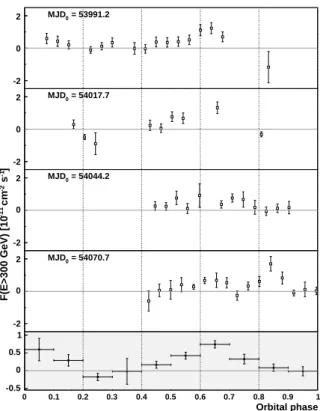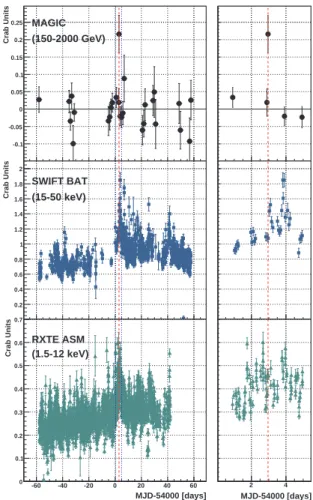February 3, 2009 15:30 WSPC - Proceedings Trim Size: 11in x 8.5in rico
1
OBSERVATIONS OF MICROQUASAR CANDIDATES WITH THE MAGIC TELESCOPE
J. RICO for the MAGIC Collaboration Institut de Fisica d’Altes Energies (IFAE) Edifici Cn. Universitat Autonoma de Barcelona
08193 Bellaterra (Barcelona) Spain E-mail: jrico@ifae.es
www.ifae.es
We report on the results from the observations in very high energy band (VHE, E
γ≥ 100 GeV) of the γ-ray binary LS I +61 303 and the black hole X-ray binary (BHXB) Cygnus X-1. LS I +61 303 was recently discovered at VHE by MAGIC [1] and here we present the preliminary results from an extensive observation campaign, comprising 112 observation hours covering 4 orbital cycles, aiming at determining the time-dependent features of the VHE emission.
Cygnus X-1 was observed for a total of 40 hours during 26 nights, spanning the period between June and November 2006. We report on the results of the searches for steady and variable γ-ray signals from Cyngus X-1, including the first experimental evidence for an intense flare, of duration between 1.5 and 24 hours.
Keywords: Very High Energy gamma-rays; binaries; LS I +61 303; Cygnus X-1
1. Introduction
Binary systems containing a compact object and a main-sequence star have been recently established as a new population of VHE emitters, by the de- tection of PSR B1259−63 [2], LS I+61 303 [1] and LS 5039 [3]. In PSR B1259 − 63 the VHE emission is thought to be produced by the interaction of the relativistic wind from a young pulsar with the out- flow of the companion star. Recent results may sug- gest that LS I +61 303 also contains a non-accreting neutron star [4], although this question is currently under debate (e.g. [5]). The situation is also unclear for of LS 5039 [6, 7], whose compact object nature is not known. To date, however, there has been no experimental evidence of VHE emission from any galactic black hole X-ray binary (BHXB) system. In the present paper we summarize recent results ob- tained with the MAGIC telescope on the study of binary systems, including a deep study of the time- dependent features of LS I+61 303 VHE emission, and the first solid experimental evidence of emission from a BHXB, namely Cygnus X-1.
2. LS I+61 303
LS I+61 303 is an X-ray binary system located at a distance of ∼ 2 kpc, composed of a B0 main se- quence star with a circumstellar disc and a compact object (probably a neutron star) orbiting around it in a highly eccentric (e = 0.72± 0.15) orbit. The orbital period is 26.496 days with the periastron passage at
phase φ = 0.23 ± 0.02 [8]. The orbital motion seems to modulate the emissions at radio [9, 10] and X- ray [11, 12] bands. LS I+61 303 is also positionally coincident with an EGRET γ-ray source [13], and variable emission at VHE has been recently detected with the MAGIC telescope [1]. Although previously considered a microquasar [14], recent VLBA imaging [4] over a full orbit showed the radio emission to come from angular scales smaller than about 7 mas (pro- jected size 14 AU) and to be cometary-like, roughly pointing away from the high-mass star. Based on these findings, it was suggested that LS I+61 303 is a pulsar wind nebula shaped by an anisotropic en- vironment.
LS I +61 303 was re-observed with MAGIC for 112 hours, covering 4 different orbital cycles from September to December 2006. Our measurements show that the VHE γ-ray emission from LS I+61 303 is variable. The integral γ-ray flux coming from the direction of LS I+61 303 in a day-by-day basis is presented in Fig. 1 and phase-folded (together with measurements from the 2005 campaign [1]) in Fig. 2.
The maximum flux is detected at around phase Φ =
0.6 − 0.7 for every orbital cycle. This points to the
possible periodicity of the VHE signal. Deeper stud-
ies on the matter will be presented elsewhere in the
near future. On the other hand, this level of flux is
not detected at periastron passage. Interestingly, a
secondary peak at phase ∼ 0.85 is seen in the last
observed cycle, with a flux of 17.0 ± 4.4 × 10
−12cm
−2s
−1. This corresponds to a similar level of flux de-
February 3, 2009 15:30 WSPC - Proceedings Trim Size: 11in x 8.5in rico
2
tection seen in phase ∼ 0.6 (e.g. day 54035.11). How- ever, this high flux was not seen in the previous cy- cle, where an upper limit is set at phase 0.82 with 5.0 × 10
−12cm
−2s
−1or even the previous one, with φ = 0.81 and an upper limit of 1.9 × 10
−12cm
−2.
= 53991.2 MJD0
= 54017.7 MJD0
= 54044.2 MJD0
= 54070.7 MJD0
Orbital phase
0 0.1 0.2 0.3 0.4 0.5 0.6 0.7 0.8 0.9 1
-2 0 2
-2 0 2
]-1 s-2 cm-11F(E>300 GeV) [10
-2 0 2
-2 0 2
-0.5 0 0.5 1
Fig. 1. VHE (E > 300GeV) gamma-ray flux of LS I+61 303 as a function of the orbital phase for the four observed orbital cycles (4 upper panels) and averaged for the entire observation time (lowermost panel).
We have searched the data set for intra-night variability, covering 87 different observation nights, on time scales from 15 to 75 minutes. Most of the observation slots last 2-3 hours except for two of them, lasting more than 4 hours. All obtained nightly lightcurves are well fitted by a constant flux level.
The chi-square distribution for all different time bin- nings indicates that no flux level variations on time scales between 30-75 min occur in the source within the sensitivity of the MAGIC telescope.
The spectrum of LS I+61 303 does not ex- hibit changes in the spectral shape during differ- ent observed phases on time scales of one year. The VHE spectra derived from both campaigns between
∼ 300 GeV and ∼ 4 TeV are shown in Fig. 3. The
reference red dotted black line corresponds to the 2005 campaign data (averaged for phases 0.4-0.7), fitted by a power law with spectral index 2.6 ± 0.2(stat)±0.2(syst). For the 2006 campaign, the spec- tra for phases [0.5-0.6] and [0.6-0.7] are presented.
We found that one universal photon index is enough to describe the spectral behavior in all phase bins investigated.
Orbital Phase 0 0.1 0.2 0.3 0.4 0.5 0.6 0.7 0.8 0.9 1 ]
-1s
-2cm
-12F(E>400GeV) [10
-20 -10 0 10
20
Period 1Period 2 Period 3 Period 4 Period 5 Period 6 Period 7 Period 8 Period 9 Period 10
preliminary
Fig. 2. Integral γ-ray flux (E > 400 GeV) lightcurve on a day-by-day basis folded with the orbital period of 26.496 days phaseogram. Each color represent a different orbital cycle.
E (GeV)
102 103 104
)-1s-2cm-1dN/dE (TeV
10-15
10-14
10-13
10-12
10-11
10-10
10-9
Spectrum dN/dE
Cycle I
<0.7 φ Cycle II 0.6<
<0.6 φ Cycle II 0.5<
Preliminary
Fig. 3. Differential energy spectrum of LS I+61 303 for en- ergies between 300 GeV and 4 TeV and averaged for maximal flux orbital phases. The dashed line corresponds to the power law fit to fluxes in the 2005 campaign [1]. The blue and red points correspond to measured fluxes in the 2006 campaign for orbital phases 0.5-0.6 and 0.6-0.7 respectively.
3. Cygnus X-1
Cygnus X-1, located at a distance of 2.2 ± 0.2 kpc, is
composed of a 21 ± 8 M
⊙BH orbiting an O9.7 Iab
companion of 40 ± 10 M
⊙[15] in a circular orbit of 5.6
February 3, 2009 15:30 WSPC - Proceedings Trim Size: 11in x 8.5in rico
3
days and inclination between 25
◦and 65
◦[16]. The X-ray source is likely powered by accretion. Obser- vations in the soft γ-ray range with COMPTEL [17]
and INTEGRAL [18] strongly suggest the presence of a higher energy, non-thermal component. Images with the VLBA have shown the presence of a highly collimated relativistic jet [19]. The interaction of the jet with the interstellar medium appears to be re- sponsible for a large-scale ( ∼ 5 pc diameter), ring- like, radio emitting structure [20].
Energy [GeV]
102 103
]-1 TeV-1 s-2Flux (dN/dE dA dt) [cm
10-15 10-14 10-13 10-12 10-11 10-10 10-9 10-8
-1] -1 TeV -2 s 0.6 [cm
± -3.2 1 TeVE 10-12
×
±0.6) = (2.3 dA dt dE
dN
Crab Nebula Cyg X-1 2006-09-24 Cyg X-1 steady
MAGIC
Fig. 4. Differential energy spectrum from Cygnus X-1 corre- sponding to 78.9 minutes effective observation time (EOT) be- tween MJD 54002.928 and 54002.987 (2006-09-24). Also shown are the Crab nebula spectrum and the best fit of a power-law to the data and the 95% CL upper limits to the steady γ-ray flux.
Cygnus X-1 was observed with MAGIC between June and November 2006 (MJD=53942 to 54058) [21]. The data set comprises 40.0 good observation hours from 26 different nights. A search for steady γ-ray signals was performed for the entire recorded data sample, yielding no significant excess. This al- lows us to establish the first upper limits to the VHE γ-ray steady flux of Cygnus X-1 of the order of ≤ 1 − 5% of the Crab nebula flux (see Fig. 4).
Gamma-ray signals were also searched for on a daily basis. We obtain results compatible with background fluctuations at 99% CL for all searched samples except for MJD=54002.875 (2006-09-24). The data from 2006-09-24 were further subdivided into two halves to search for rapidly varying signals, obtain- ing 0.5σ and 4.9σ results for the first (75.5 minutes EOT starting at MJD 54002.875) and second (78.9 minutes EOT starting at MJD 54002.928) samples, respectively. The post-trial probability is conserva- tively estimated by assuming 52 trials (2 per observa- tion night) and corresponds to a significance of 4.1σ.
Crab Units
-0.1 -0.05 0 0.05 0.1 0.15 0.2 0.25 MAGIC
(150-2000 GeV)
Crab Units
0.2 0.4 0.6 0.8 1 1.2 1.4 1.6 1.8 2
SWIFT BAT (15-50 keV)
MJD-54000 [days]
-60 -40 -20 0 20 40 60
Crab Units
0 0.1 0.2 0.3 0.4 0.5 0.6 0.7
RXTE ASM (1.5-12 keV)
MJD-54000 [days]
2 4

